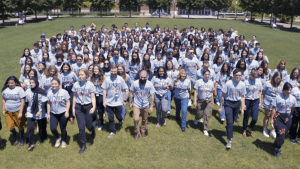Local and federal officials gather in Smithfield as Birmingham received $50 million transformative grant from HUD. (HABD)
” data-medium-file=”https://www.birminghamtimes.com/wp-content/uploads/2023/09/Image46-300×194.png” data-large-file=”https://www.birminghamtimes.com/wp-content/uploads/2023/09/Image46-1024×662.png” />
By Ryan Michaels
The Birmingham Times
Dontrelle Young-Foster, President and CEO, of the Housing Authority of the Birmingham District (HABD), got an email in midsummer that required her to do something she jokingly said she wasn’t used to doing—keeping quiet.
“That’s the first time I’ve really had to be very disciplined and keep my mouth quiet, but we didn’t want to do anything to jeopardize [a historic] opportunity,” she said. “So, we just kept the joy inside us until the moment came that we could share it publicly.”
Young-Foster had received word that the city would be receiving a $50 million federal grant to transform the Smithfield community.
The public announcement came a week later, on a blistering hot Wednesday morning, when media, community organization leaders, and city residents huddled under a tent in West Birmingham with local and national officials to hear Marcia Fudge, secretary of the U.S. Department of Housing and Urban Development (HUD), announce that the HABD and the city had been awarded a transformative $50 million.
When it was her turn to speak, Young-Foster stood before a packed crowd and finally got her a chance to open up: “The emotions I feel are indescribable. It is official. It is real, Birmingham. It is real, Smithfield,” she said between applause and cheers.
The $50 million was administered through HUD’s Choice Neighborhoods (CN) grant program, which is intended to help rehabilitate ailing public housing developments throughout the nation and transform them into more livable places.
The city plans to use the funds to kickstart a $294 million investment in the Smithfield, College Hills, and Graymont neighborhoods, providing 1,000 subsidized, affordable, market-value homes to replace the 900 units of the aging Smithfield Court.
The HUD victory for the city was put in motion long before that Wednesday in July. It can be traced back to 2012 with a team that included Young-Foster; Birmingham Mayor Woodfin; Kelvin Datcher, Woodfin’s director of intergovernmental affairs; U.S. Rep. Terri Sewell (AL-07) and other partners.
Here’s how the city of Birmingham secured one of the most significant federal grants in its recent history.
” data-medium-file=”https://www.birminghamtimes.com/wp-content/uploads/2023/09/Smithfield_HUD-2-300×193.jpg” data-large-file=”https://www.birminghamtimes.com/wp-content/uploads/2023/09/Smithfield_HUD-2-1024×659.jpg” class=”wp-image-114819 size-large” src=”https://www.birminghamtimes.com/wp-content/uploads/2023/09/Smithfield_HUD-2-1024×659.jpg” alt=”” width=”640″ height=”412″ srcset=”https://www.birminghamtimes.com/wp-content/uploads/2023/09/Smithfield_HUD-2-1024×659.jpg 1024w, https://www.birminghamtimes.com/wp-content/uploads/2023/09/Smithfield_HUD-2-300×194.jpg 300w, https://www.birminghamtimes.com/wp-content/uploads/2023/09/Smithfield_HUD-2-768×494.jpg 768w, https://www.birminghamtimes.com/wp-content/uploads/2023/09/Smithfield_HUD-2-652×420.jpg 652w, https://www.birminghamtimes.com/wp-content/uploads/2023/09/Smithfield_HUD-2-341×220.jpg 341w, https://www.birminghamtimes.com/wp-content/uploads/2023/09/Smithfield_HUD-2-640×412.jpg 640w, https://www.birminghamtimes.com/wp-content/uploads/2023/09/Smithfield_HUD-2-681×438.jpg 681w, https://www.birminghamtimes.com/wp-content/uploads/2023/09/Smithfield_HUD-2.jpg 1322w” sizes=”(max-width: 640px) 100vw, 640px” />
Seeds of the Victory
The HABD first applied for a CN planning grant in 2012 for the now former Loveman Village housing development in Birmingham’s Titusville community. The next year, the city applied for a planning grant at the Charles P. Marks Village public housing site. Though neither of those panned out, leadership around Birmingham didn’t give up. Their focus shifted to the Smithfield community.
In October 2017, Woodfin was first elected mayor of Birmingham and Datcher came on as Woodfin’s director of intergovernmental affairs. By January 2018, Datcher, Woodfin, and Michael Lundy, then the HABD’s executive director, surveyed maps of the public housing communities in the city and decided that the Smithfield community would be a perfect area for a grant application.
” data-medium-file=”https://www.birminghamtimes.com/wp-content/uploads/2023/09/image0-200×300.jpeg” data-large-file=”https://www.birminghamtimes.com/wp-content/uploads/2023/09/image0-683×1024.jpeg” class=”wp-image-114816 size-medium” src=”https://www.birminghamtimes.com/wp-content/uploads/2023/09/image0-200×300.jpeg” alt=”” width=”200″ height=”300″ srcset=”https://www.birminghamtimes.com/wp-content/uploads/2023/09/image0-200×300.jpeg 200w, https://www.birminghamtimes.com/wp-content/uploads/2023/09/image0-683×1024.jpeg 683w, https://www.birminghamtimes.com/wp-content/uploads/2023/09/image0-768×1151.jpeg 768w, https://www.birminghamtimes.com/wp-content/uploads/2023/09/image0-280×420.jpeg 280w, https://www.birminghamtimes.com/wp-content/uploads/2023/09/image0-640×959.jpeg 640w, https://www.birminghamtimes.com/wp-content/uploads/2023/09/image0-681×1020.jpeg 681w, https://www.birminghamtimes.com/wp-content/uploads/2023/09/image0.jpeg 1001w” sizes=”(max-width: 200px) 100vw, 200px” />
“We looked at which [communities] could have the largest impact on the city if we went all in on an application. … We [chose] Smithfield because of great community assets, such as Legion Field, McClendon Park, a fire station, a library, and, of course, A.H. Parker High School, … all [of which were valuable] resources to leverage on an application,” said Datcher, who first heard about the CN program when he served as chief of staff for now Jefferson County Commissioner Sheila Tyson during her time as a Birmingham City Councilor.
Datcher said Woodfin’s insight, given that he grew up with numerous family members living in public housing throughout the city, was helpful in the process.
“Moving the Needle Forward”
In 2020, the HABD first applied for a CN implementation grant to demolish and redevelop the Smithfield Court and Elyton Village public housing developments and the surrounding areas.
The HABD hired two teams of consultants, while the city of Birmingham brought on its Community Development Department, the former Jefferson County Committee for Economic Opportunity (JCCEO), and a variety of other community partners to assist with the first grant application.
The CN grant is “one of the most competitive, if not the single most competitive, annual grant that the federal government awards,” Datcher said. “More than 100 cities always begin down the road for application, but it’s such a heavy lift. For instance, this year, 22 cities submitted full applications, there were eight finalists, and then eight winners. It is incredibly competitive.”
When submitting the first CN application in 2020, Datcher and the team didn’t expect to win the grant but knew they would gain valuable insight about putting together the proposal.
“We knew we were moving the needle forward,” said Datcher. “So, even if we were not awarded, which we weren’t, we knew that it could be a step in the right direction.”
Between the springs of 2021 and 2022, representatives of the city’s Department of Community Development, the mayor’s office, and the HABD participated in several meetings with HUD, even traveling to Washington, D.C., where they met with 20 leaders of the agency, including Brian D. Montgomery, who was then HUD’s deputy secretary.
Also, in April 2022 Meghan Venable-Thomas joined the city of Birmingham as director of the Department of Community Development, one of the lead city departments driving the CN application.
Together with Cory Stallworth, senior deputy director for the Department of Community Development, Venable-Thomas and the team started working to address two big pieces of advice HUD provided for the city to improve its second application. HUD wanted to see Birmingham bring on more community partners for the redevelopment plan and to see greater financial commitment from the city, Venable-Thomas said.
“[HUD wants] to see that your local organizations, your government, your partners are not just committed to support but are committed to find financial support because they want to know that … we can make that seed of funding [HUD is] bringing to the table grow,” she added.
The city committed more of its own money to the project through the $4.59 million acquisition of surplus property on the grounds of A.H. Parker High School, on top of plans to leverage more than tens of millions in housing, people, education, and community investments.
Meanwhile, Young-Foster, who began serving as executive director of the HABD in an interim role in February 2022 before becoming the permanent head in June of that year, agreed that the initial application was a learning experience. That first try at winning the grant for Smithfield gave the HABD some practice and early relationships with partners who would be critical to the winning application.
“We didn’t have to reinvent the wheel,” she said. “We picked up where we left off, and then we added more partners and strengthened the application in that manner.”
Top Priority
Once at the helm of the HABD, working on a winning grant application became one of Young-Foster’s top priorities, especially as HUD had upped the maximum grant amount from $35 million to $50 million.
“This was an every-day, all-day effort because we knew how important it was,” she said. “We’d never seen this grant before in the state of Alabama, so it was critical for us to put our efforts in this grant because [HABD] has more than 14 communities, and we’re trying to redevelop all of our communities.”
To secure the grant, Young-Foster estimates that the HABD collaborated with more than 50 partners, some of the biggest being the city of Birmingham and UAB, as well as the developers for the project, Integral/Rule Enterprises, based in Atlanta, Georgia.
Having applied for the previous grant came in handy, Young-Foster said: “Everybody was committed when we started the first round, so it wasn’t new when we came back around this final time to have those conversations. I think they were all ready.”
“We were aligned on one mission: to improve the lives of Smithfield residents and the entire community,” she added.
In addition to the core team of partners, three task forces were set up: people/education, led by Atlanta-based The Ascent Project; housing, led by Integral/Rule Enterprises; and neighborhood, led by the city of Birmingham. Each task force included residents of the Smithfield, College Hills, and Graymont neighborhoods.
Adrienne Reynolds, president of the Smithfield community advisory committee, said the development is “long overdue and needed.”
“I cannot remember in my lifetime the last time that a new house was even built in the Smithfield neighborhood,” said Reynolds, a 1975 graduate of A.H. Parker High School.
The new homes could bring in new families, which are desperately needed to keep neighborhoods alive, Reynolds added.
“It’s designed to bring in families with growing children,” she said. “When you bring in young families, that’s going to be better in the long run not only for the neighborhood but also for the schools, surroundings, and everything else.”
” data-medium-file=”https://www.birminghamtimes.com/wp-content/uploads/2023/09/Image37-300×194.png” data-large-file=”https://www.birminghamtimes.com/wp-content/uploads/2023/09/Image37-1024×662.png” class=”wp-image-114820 size-large” src=”https://www.birminghamtimes.com/wp-content/uploads/2023/09/Image37-1024×662.png” alt=”” width=”640″ height=”414″ srcset=”https://www.birminghamtimes.com/wp-content/uploads/2023/09/Image37-1024×662.png 1024w, https://www.birminghamtimes.com/wp-content/uploads/2023/09/Image37-300×194.png 300w, https://www.birminghamtimes.com/wp-content/uploads/2023/09/Image37-768×497.png 768w, https://www.birminghamtimes.com/wp-content/uploads/2023/09/Image37-649×420.png 649w, https://www.birminghamtimes.com/wp-content/uploads/2023/09/Image37-341×220.png 341w, https://www.birminghamtimes.com/wp-content/uploads/2023/09/Image37-640×414.png 640w, https://www.birminghamtimes.com/wp-content/uploads/2023/09/Image37-681×440.png 681w, https://www.birminghamtimes.com/wp-content/uploads/2023/09/Image37.png 1500w” sizes=”(max-width: 640px) 100vw, 640px” />
Once HABD heard that HUD had opened applications for the $50 million grant in the 2023 cycle, Young-Foster said partners for the project went from meeting weekly to meeting daily to prepare for the application deadline, which was Jan. 11, 2023.
A Long Three Months
While team members in Birmingham were putting the finishing touches on the application, U.S. Rep. Sewell, who had already provided a letter of support for the grant, then made the case directly to HUD Secretary Fudge.
Anytime the congresswoman saw Fudge—whether it was Medal of Honor events, the annual Congressional Picnic, or committee meetings—Sewell reminded the HUD secretary about Birmingham’s application: “We would talk about the historic nature of Smithfield, what it meant during the Civil Rights movement, the amazing people who came from that neighborhood, … making sure [HUD] knew the story of the residents of Smithfield and what this project would mean to them and to the quality of life for them.”
“I think I bugged her more than anybody, since she was actually a former colleague of mine,” Sewell said of Fudge, who previously served as a U.S. Representative for Ohio from 2008 to 2021.
On April 17, HUD announced the eight finalists for the grants. The HABD appeared on the list next to seven other applicants from cities across the nation, including Atlanta, Georgia; Lake Charles, Louisiana; Miami-Dade County, Florida; Philadelphia, Pennsylvania; Pittsburgh, Pennsylvania; Tucson, Arizona; and Wilmington, Delaware.
After finding out Birmingham had made the short list, preparations were made to host HUD officials. On May 11, HUD made a site visit, starting at Legion Field, where representatives of the HABD, the city, the developers; Birmingham City Schools (BCS); United Way of Central Alabama (UWCA); the Birmingham-Jefferson County Transit Authority (BJCTA); and the University of Alabama at Birmingham (UAB), as well as developers, residents, and others gathered.
From there the visitors took a three-hour tour of the community, during which an in-depth explanation of the actual proposal began. Separate Birmingham teams gave presentations on neighborhood, housing, and people strategies, respectively. The day ended with a wrap-up of the project goals and impacts. When the HUD representatives left, Young-Foster remembers everyone feeling “an adrenaline rush” and “walking away smiling” from the comments they had heard.
“[HUD was] very impressed with the presentations,” Young-Foster recalled. “They were very impressed with the community and the transformation plan we presented to them. They [also] were very impressed by the presentation of the partners that were there supporting application beside our residents.”
After that point, all the HABD could do was wait and continue to keep residents informed about the plan.
“We were continuing our outreach. We were putting out newsletters. We were updating that website, so [we could] stay visual. We kept the communication going,” Young-Foster said. “We were very confident, and we were manifesting [a win].”
Collective Celebration
Datcher remembers getting the notice that the city had received the grant. “There were some pretty loud screams at City Hall that day,” he recalled.
Venable-Thomas said she remembered getting a call from Woodfin. “I happened to be in a meeting with the rest of the team, and he was like, ‘Great. Tell everybody,’” she said.
“[I] was overjoyed to hear that we were going to be able to get this type of investment in our community and that HUD, at a national level, saw that this was important and that we deserve something like this in Birmingham,” Venable-Thomas added.
Following the official announcement on July 26, Venable-Thomas said she was excited to hear Fudge say Birmingham’s application was one of the best she had ever seen. At the announcement on that sweltering summer morning, Woodfin likened the situation to another common event inside a hot tent.
“Y’all ever been under a revival tent?” the mayor asked. “So, none of y’all should be a stranger to this, right? This blessing we’re receiving right now or this heat y’all feel right now?”
It’s appropriate that the grant is known as “Choice Neighborhoods,” Woodfin said, because of the importance of that word to the community and to elected officials.
He added, “It was our choice to make every one of our neighborhoods great places to live. It was A.H. Parker’s choice in 1900 to build a world-renowned high school for African Americans just a few blocks away from here, where we stand.
“It was [a] choice for Arthur Shores, [renowned Civil Rights attorney, often heralded as ‘Alabama’s Drum Major for Justice’], and the families and churches of Dynamite Hill, [a moniker given to the area that was beset by regular bombings by Ku Klux Klan members regularly during the Civil Rights era], to stand strong in the face of hatred,” said the mayor.
Sewell said success came from everyone involved working as a team.
“An effort like this takes lots of different players,” she said. “What I am just so appreciative of is that the city of Birmingham and residents of the Smithfield, College Hills, and Graymont neighborhoods—we all consistently sang from the same page.”
The congresswoman added that Smithfield is “the epicenter” for that area of the community and that the grant will bring housing, a better quality of life, and economic development to the city.
“This is really a win-win for the city, a win for the Smithfield, Graymont and College Hills neighborhoods, but it’s also a huge win, overall, for the city,” said Sewell.











